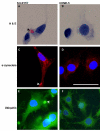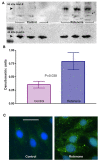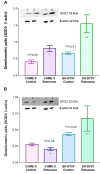Effects of chronic low dose rotenone treatment on human microglial cells
- PMID: 20042120
- PMCID: PMC2806357
- DOI: 10.1186/1750-1326-4-55
Effects of chronic low dose rotenone treatment on human microglial cells
Abstract
Background: Exposure to toxins/chemicals is considered to be a significant risk factor in the pathogenesis of Parkinson's disease (PD); one putative chemical is the naturally occurring herbicide rotenone that is now used widely in establishing PD models. We, and others, have shown that chronic low dose rotenone treatment induces excessive accumulation of Reactive Oxygen Species (ROS), inclusion body formation and apoptosis in dopaminergic neurons of animal and human origin. Some studies have also suggested that microglia enhance the rotenone induced neurotoxicity. While the effects of rotenone on neurons are well established, there is little or no information available on the effect of rotenone on microglial cells, and especially cells of human origin. The aim of the present study was to investigate the effects of chronic low dose rotenone treatment on human microglial CHME-5 cells.
Methods: We have shown previously that rotenone induced inclusion body formation in human dopaminergic SH-SY5Y cells and therefore used these cells as a control for inclusion body formation in this study. SH-SY5Y and CHME-5 cells were treated with 5 nM rotenone for four weeks. At the end of week 4, both cell types were analysed for the presence of inclusion bodies, superoxide dismutases and cell activation (only in CHME-5 cells) using Haematoxylin and Eosin staining, immunocytochemical and western blotting methods. Levels of active caspases and ROS (both extra and intra cellular) were measured using biochemical methods.
Conclusion: The results suggest that chronic low dose rotenone treatment activates human microglia (cell line) in a manner similar to microglia of animal origin as shown by others. However human microglia release excessive amounts of ROS extracellularly, do not show excessive amounts of intracellular ROS and active caspases and most importantly do not show any protein aggregation or inclusion body formation. Human microglia appear to be resistant to rotenone (chronic, low dose) induced damage.
Figures





Similar articles
-
Critical role for microglial NADPH oxidase in rotenone-induced degeneration of dopaminergic neurons.J Neurosci. 2003 Jul 16;23(15):6181-7. doi: 10.1523/JNEUROSCI.23-15-06181.2003. J Neurosci. 2003. PMID: 12867501 Free PMC article.
-
Ultrafine carbon particles promote rotenone-induced dopamine neuronal loss through activating microglial NADPH oxidase.Toxicol Appl Pharmacol. 2017 May 1;322:51-59. doi: 10.1016/j.taap.2017.03.005. Epub 2017 Mar 7. Toxicol Appl Pharmacol. 2017. PMID: 28283350
-
Vitamin K2 suppresses rotenone-induced microglial activation in vitro.Acta Pharmacol Sin. 2016 Sep;37(9):1178-89. doi: 10.1038/aps.2016.68. Epub 2016 Aug 8. Acta Pharmacol Sin. 2016. PMID: 27498777 Free PMC article.
-
Microglial Activation Mediates Noradrenergic Locus Coeruleus Neurodegeneration via Complement Receptor 3 in a Rotenone-Induced Parkinson's Disease Mouse Model.J Inflamm Res. 2021 Apr 9;14:1341-1356. doi: 10.2147/JIR.S299927. eCollection 2021. J Inflamm Res. 2021. PMID: 33859489 Free PMC article.
-
1,25-Dyhydroxyvitamin D₃ attenuates rotenone-induced neurotoxicity in SH-SY5Y cells through induction of autophagy.Biochem Biophys Res Commun. 2014 Aug 15;451(1):142-7. doi: 10.1016/j.bbrc.2014.07.081. Epub 2014 Jul 29. Biochem Biophys Res Commun. 2014. PMID: 25078626
Cited by
-
Pharmacological effects of active compounds on neurodegenerative disease with gastrodia and uncaria decoction, a commonly used poststroke decoction.ScientificWorldJournal. 2013 Nov 14;2013:896873. doi: 10.1155/2013/896873. ScientificWorldJournal. 2013. PMID: 24348193 Free PMC article. Review.
-
Immune cell metabolic dysfunction in Parkinson's disease.Mol Neurodegener. 2025 Mar 24;20(1):36. doi: 10.1186/s13024-025-00827-y. Mol Neurodegener. 2025. PMID: 40128809 Free PMC article. Review.
-
Toxicity, recovery, and resilience in a 3D dopaminergic neuronal in vitro model exposed to rotenone.Arch Toxicol. 2018 Aug;92(8):2587-2606. doi: 10.1007/s00204-018-2250-8. Epub 2018 Jun 28. Arch Toxicol. 2018. PMID: 29955902 Free PMC article.
-
Mitochondrial dysfunction in glial cells: Implications for neuronal homeostasis and survival.Toxicology. 2017 Nov 1;391:109-115. doi: 10.1016/j.tox.2017.06.011. Epub 2017 Jun 26. Toxicology. 2017. PMID: 28655545 Free PMC article. Review.
-
Molecular responses differ between sensitive silver carp and tolerant bighead carp and bigmouth buffalo exposed to rotenone.Fish Physiol Biochem. 2012 Oct;38(5):1379-91. doi: 10.1007/s10695-012-9625-1. Epub 2012 Mar 25. Fish Physiol Biochem. 2012. PMID: 22447502
References
-
- Hirsch EC, Hunot S, Damier P, Faucheux B. Glial cells and inflammation in Parkinson's disease: a role in neurodegeneration? Ann Neurol. 1998;44:S115–120. - PubMed
-
- McGeer PL, Itagaki S, Boyes BE, McGeer EG. Reactive microglia are positive for HLA-DR in the substantia nigra of Parkinson's and Alzheimer's disease brains. Neurology. 1988;38:1285–1291. - PubMed
LinkOut - more resources
Full Text Sources

